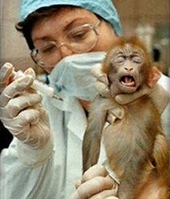Animal testing: being cruel to be kind, or just being cruel?
13 Feb 2016
The University of Oxford was recently revealed to have topped the list of universities using animal testing with a total of 226,739 animals used in experiments in 2014, followed by the University of Edinburgh with 200,861 and University College London with 176,901 animals used.
 King's College London and the University of Cambridge were fourth and fifth with 165,068 and 160,557 animals used, respectively. The list was compiled by an anti-vivisection organisation Cruelty Free International, which obtained the figures by Freedom of Information requests.
King's College London and the University of Cambridge were fourth and fifth with 165,068 and 160,557 animals used, respectively. The list was compiled by an anti-vivisection organisation Cruelty Free International, which obtained the figures by Freedom of Information requests.
The University of Oxford claims to be one of the world's leading centres for biomedical research. They study health problems like cancer, heart disease, diabetes, HIV, Alzheimer's, and Parkinson's through the use of animals in certain research projects.
Their latest £18 million Biomedical Sciences Building, which houses all the animal research projects, has been referred to as the ''gold standard'' for animal research facilities. Needless to say, they consider using animals for research to still be essential for medical progress.
However, with reports of monkey experiments at some universities said to involve deprivation of food or water and other experiments containing pregnant sheep being injected with testosterone twice a week or having their ovaries punctured during surgery, it is hard to ignore the inhumane and unethical methods of animal research.
The standards are not the same at every research setting. Furthermore, Dr Katy Taylor, director of science at Cruelty Free International, said, ''The public will be shocked to learn that five of the UK's leading universities are responsible for testing on almost one million animals, despite an increasing number of universities recognising this isn't the way to do research.''
The University of Oxford's current policy appears to want to minimise the use of animals in research while also being able to make significant advances on important problems of human health.
The policy is able to do the first part in relation to the primates it houses (0.5 per cent of all the animals the university houses), as the research facility went from holding 109 primates to 55. However, they intend to replace the primates with lower orders of animal, which just means that what will decrease in one area will increase in another.
The medical field argues that without animals, only very limited progress can be made against diseases like cancer, heart attack, diabetes and HIV.
However, as former US National Cancer Institute director, Dr Richard Klausner, states, ''We have cured mice of cancer for decades – and it simply didn't work in humans.'' Thus, other methods present due to biotechnology like organs-on-a-chip and computer modelling that predict what will happen in humans seem to be a more ethical alternative in regards to behavioural neuroscience research.
Despite this disappointment from cancer research, Type 1 diabetes appears to have benefitted from animal research. The development of the first stem-cell treatment was increased due to animal research demonstrating the technique could possibly cure it.
This technique is an incredible accomplishment towards the potentially life-threatening hormonal disorder that affects 24.5 per 100,000 children aged 0 to 14 in the UK every year. Thus, not only has animal trials been indicated to have been useful in some cases, it has also been highlighted that more than half the drugs used by veterinarians were aimed originally as human medication.
University of Kent itself has used animals including rabbits, toads, goldfish, mice and rats for experiments. It was reported that between 2010 and 2013 staff at the Faculty of Sciences on the Canterbury campus experimented on and killed 258 mice. The university also follows the ideology of using animals for its research ''where no alternatives are available'', and the reported number is still far less compared to the universities that have topped the current, and previous, lists.
Currently, animals appear to be the closest living substitutes that can be controlled for variables and still provide significant results in a naturalistic environment for various medical fields in an academic setting. Even so, the strict control and the increasing pressure from the governing bodies and outside organisations are helping laboratories constantly to find new ways to conduct these experiments without animal subjects. However, technology will never be able to totally replace animal testing unless every possible outcome, mutation and behaviour is recorded and computed.
Yet a closer look should be taken at the research being conducted involving animals and its results in order to ensure the highest possible level of welfare for the animals.




















